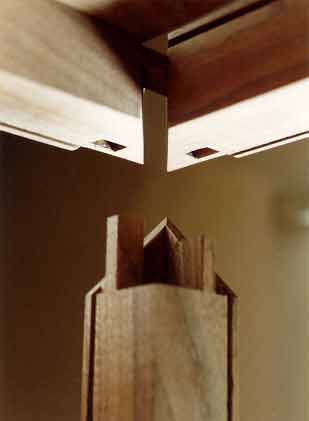Looking at classical Chinese furniture
from the ‘Golden Age’, one will surely
come across a wide range of designs utilising a broad
variety of materials. There are lacquered examples
as well as softwood, imperial and the hardwood types.
The pieces represented here only indicate the classical
styles in hardwood.
The beauty of hardwood examples lies in its simplicity
of form and intricate ornamentation. Simple forms
coupled with predetermined design concepts led to
the use of ingenious and complex joinery methods.
The intricacy of the joinery can be described as being
puzzle-like. Because no dowels, nails, screws or similar
fixtures are employed, the most common method of putting
together furniture parts is by a system of complex
mortise and tenon; sliding dovetail; pressure-pegged
lapped joints, etc. With each type of joinery there
are numerous combinations each suited for a particular
purpose.
|

For example, the mortise and tenon
joint for connecting circular members at right angles
requires the tenon member to have curved shoulders
that fit onto the mortised member.
|

A mitred mortise and tenon is
standard for framework but it poses a challenge
to the artisan when it becomes a three corner member
mitre mortise and tenon joint.
|
The reader should note that where the contemporary
furniture maker will emphasise a joint for aesthetics,
the Chinese furniture maker will do the opposite and
conceal most joints. Only the wood, its texture, ornamentation
and form are emphasised. With this understanding we
can appreciate the furniture from a totally different
perspective, that is the world of hidden joinery. |